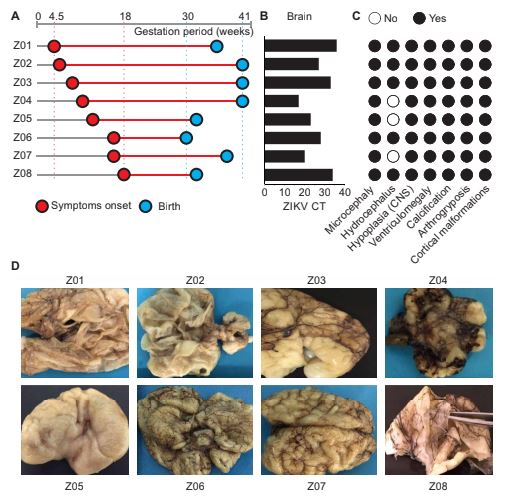Molecular alterations in the extracellular matrix in the brains of newborns with congenital Zika syndrome.
Zika virus (ZIKV) infection during pregnancy can cause a set of severe abnormalities in the fetus known as congenital Zika syndrome (CZS). Experiments with animal models and in vitro systems have substantially contributed to our understanding of the pathophysiology of ZIKV infection. Here, to investigate the molecular basis of CZS in humans, we used a systems biology approach to integrate transcriptomic, proteomic, and genomic data from the postmortem brains of neonates with CZS. We observed that collagens were greatly reduced in expression in CZS brains at both the RNA and protein levels and that neonates with CZS had several single-nucleotide polymorphisms in collagen-encoding genes that are associated with osteogenesis imperfecta and arthrogryposis. These findings were validated by immunohistochemistry and comparative analysis of collagen abundance in ZIKV-infected and uninfected samples. In addition, we showed a ZIKV-dependent increase in the expression of cell adhesion factors that are essential for neurite outgrowth and axon guidance, findings that are consistent with the neuronal migration defects observed in CZS. Together, these findings provide insights into the underlying molecular alterations in the ZIKV-infected brain and reveal host genes associated with CZS susceptibility.
Authors
Renato S Aguiar; Fabio Pohl; Guilherme L Morais; Fabio C S Nogueira; Joseane B Carvalho; Letícia Guida; Luis W P Arge; Adriana Melo; Maria E L Moreira; Daniela P Cunha; Leonardo Gomes; Elyzabeth A Portari; Erika Velasquez; Rafael D Melani; Paula Pezzuto; Fernanda L de Castro; Victor E V Geddes; Alexandra L Gerber; Girlene S Azevedo; Bruno L Schamber-Reis; Alessandro L Gonçalves; Inácio Junqueira-de-Azevedo; Milton Y Nishiyama; Paulo L Ho; Alessandra S Schanoski; Viviane Schuch; Amilcar Tanuri; Leila Chimelli; Zilton F M Vasconcelos; Gilberto B Domont; Ana T R Vasconcelos; Helder I Nakaya
External link
Publication Year
Publication Journal
Associeted Project
Systems Immunology of Human Diseases
Lista de serviços
-
Genomic analyses reveal broad impact of miR-137 on genes associated with malignant transformation and neuronal differentiation in glioblastoma cells.Genomic analyses reveal broad impact of miR-137 on genes associated with malignant transformation and neuronal differentiation in glioblastoma cells.
-
RNA-Binding Protein Musashi1 Is a Central Regulator of Adhesion Pathways in Glioblastoma.RNA-Binding Protein Musashi1 Is a Central Regulator of Adhesion Pathways in Glioblastoma.
-
MicroRNA Transcriptome Profiling in Heart of Trypanosoma cruzi-Infected Mice: Parasitological and Cardiological Outcomes.MicroRNA Transcriptome Profiling in Heart of Trypanosoma cruzi-Infected Mice: Parasitological and Cardiological Outcomes.
-
Genome mapping and expression analyses of human intronic noncoding RNAs reveal tissue-specific patterns and enrichment in genes related to regulation of transcription.Genome mapping and expression analyses of human intronic noncoding RNAs reveal tissue-specific patterns and enrichment in genes related to regulation of transcription.
-
Antimicrobial peptide LL-37 participates in the transcriptional regulation of melanoma cells.Antimicrobial peptide LL-37 participates in the transcriptional regulation of melanoma cells.
-
Down-regulation of 14q32-encoded miRNAs and tumor suppressor role for miR-654-3p in papillary thyroid cancer.Down-regulation of 14q32-encoded miRNAs and tumor suppressor role for miR-654-3p in papillary thyroid cancer.
-
Integration of miRNA and gene expression profiles suggest a role for miRNAs in the pathobiological processes of acute Trypanosoma cruzi infection.Integration of miRNA and gene expression profiles suggest a role for miRNAs in the pathobiological processes of acute Trypanosoma cruzi infection.
-
Integrative Biology Approaches Applied to Human DiseasesIntegrative Biology Approaches Applied to Human Diseases
-
Proteomics reveals disturbances in the immune response and energy metabolism of monocytes from patients with septic shock.Proteomics reveals disturbances in the immune response and energy metabolism of monocytes from patients with septic shock.
-
Genomics, epigenomics and pharmacogenomics of Familial Hypercholesterolemia (FHBGEP): A study protocol.Genomics, epigenomics and pharmacogenomics of Familial Hypercholesterolemia (FHBGEP): A study protocol.
-
Melatonin-Index as a biomarker for predicting the distribution of presymptomatic and asymptomatic SARS-CoV-2 carriersMelatonin-Index as a biomarker for predicting the distribution of presymptomatic and asymptomatic SARS-CoV-2 carriers
-
Profiling plasma-extracellular vesicle proteins and microRNAs in diabetes onset in middle-aged male participants in the ELSA-Brasil study.Profiling plasma-extracellular vesicle proteins and microRNAs in diabetes onset in middle-aged male participants in the ELSA-Brasil study.
-
Big Data and machine learning in cancer theranosticsBig Data and machine learning in cancer theranostics
-
Genomic positional conservation identifies topological anchor point RNAs linked to developmental loci.Genomic positional conservation identifies topological anchor point RNAs linked to developmental loci.
-
Integrative systems immunology uncovers molecular networks of the cell cycle that stratify COVID-19 severityIntegrative systems immunology uncovers molecular networks of the cell cycle that stratify COVID-19 severity

